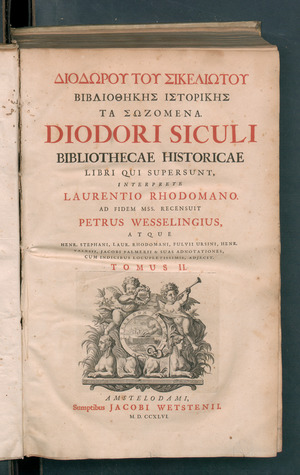Diodorus Siculus facts for kids
Diodorus Siculus was a Greek historian from Sicily. He is famous for writing a huge book called Bibliotheca historica (which means "Historical Library"). He wrote this book between 60 and 30 BC. Much of his work still exists today. The title "Bibliotheca" shows that he gathered information from many other writers, like a library collects many books.
Contents
Who Was Diodorus Siculus?
Diodorus wrote that he was born in a town called Agyrium in Sicily. Today, this town is known as Agira. Not much is known about his life, but another ancient writer named Jerome mentioned him. Jerome wrote in 49 BC that "Diodorus of Sicily, a writer of Greek history, became illustrious." This means Diodorus was well-known and respected for his historical writings.
What Was the Bibliotheca Historica?
Diodorus's book, the Bibliotheca historica, was a massive work. It originally had 40 books! Today, we still have books 1–5 and 11–20. We also have small parts of the lost books because other ancient writers copied sections of them.
How Was the Book Organized?
Diodorus divided his "Historical Library" into three main parts:
- Part 1: Mythic History (Books 1–6): This section covered ancient myths and legends from different cultures. It started with the history of non-Greek and Greek tribes up to the famous Trojan War. Diodorus organized this part by geography. He described the history and culture of places like Ancient Egypt (Book 1), Mesopotamia, India, Scythia, and Arabia (Book 2), North Africa (Book 3), and Greece and Europe (Books 4–6).
- Part 2: From Troy to Alexander (Books 7–17): This part told the story of the world from the Trojan War all the way to the death of Alexander the Great. Alexander was a very famous ancient Greek king and military leader.
- Part 3: After Alexander (Books 17 to the end): This final section covered historical events after Alexander the Great's death. It went up to about 60 BC, or possibly even the start of Julius Caesar's wars in Gaul. Since the last books are lost, we aren't exactly sure where he finished.
Where Did Diodorus Get His Information?
Diodorus used many different sources for his book. He was like a careful researcher, gathering information from earlier historians. Some of the writers he used include Hecataeus of Abdera, Ctesias of Cnidus, Ephorus, Polybius, and Posidonius. This is why he called his work a "Library"—he collected knowledge from many different "books" or authors.
What Else Did Diodorus Write About?
Diodorus included many interesting details in his history. For example, he wrote about gold mining in Nubia, which is in eastern Egypt. He described how people worked in these mines.
He also wrote about the Celts, an ancient group of people in Europe. He described them like this: "Physically the Celts are terrifying in appearance with deep-sounding and very harsh voices. In conversation they use few words and speak in riddles... They frequently exaggerate with the aim of extolling themselves and diminishing the status of others. They are boasters and threateners... and yet they are quick of mind and with good natural ability for learning." (Book 5)
See also
 In Spanish: Diodoro Sículo para niños
In Spanish: Diodoro Sículo para niños


